Reproduction
________________________________________________________
Angiosperm Breakdown
Referring back to the
classification page, Datura stramonium is a
part of the phylum Magnoliophyta more
commonly known as the Angiosperms. In general
the species in this phylum are successful in
reproduction and propagation because of their
ability to produce covered seeds. In jimson weed
this success is increase because of the
characteristic Thorn Apple.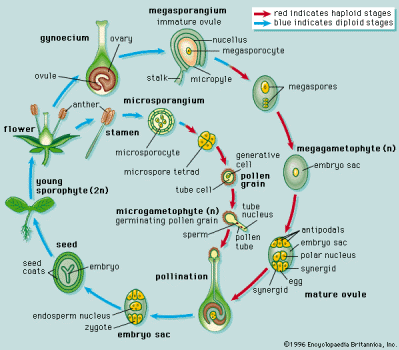
Datura Stramonium has no issues when it comes to reproduction, in fact in many places this proliferate plant can take over if the right conditions are readily available. Jimsonweed propagates solely through seeds which are released after the ripening of the typical “Thorn Apple”. The species also tends to self pollinate, and has evolved methods to reduce cross fertilization. In "Blankeslee: The Genus Datura" this self-fertilization, otherwise known as autogamy, was observed to occur as the anther of the flower opened 24 hours before the corolla unfolded (Danert 1954). After fertilization has occurred, the seeds will be disseminated upon the ripening and convulsion of the fruiting body. Typically germination of the seed will occur in 15 to 20 days.
________________________________________________________
Breeding
Datura spp. may be weed-like, but there unique and beautiful flowers are prized by many florists. Resultantly, the breeding of different species in the genus has taken place and has been documented for others to reproduce. Datura Stamonium in particular can be crossbred with D. quercifolia, D. ferox, and D. leichhardtii. It’s important to remember that these crosses are man-made as the plants characteristic autogomy must be over come.Interestingly enough only one cross breed has been found in the wild and that is between D. Stramonium and D. Ferox, which can be seen in various locations throughout South America.
________________________________________________________
Life Cycle Gallery
The following gallery depicts several stages of Datura stramonium's life cycle. Of coarse if you want to see all of the beauty jimson weed has to offer, you'll have to find the plant for yourself, or obtain some seeds to start one of your own.
 To the left is the fruiting body of Datura
strmonium. It's spiked exterior is the reason why jimson weed
has received the other name, the thorn apple. At this point in the
reproduction cycle the seeds of the plant have already been
fertilized and are developing within this protective body
To the left is the fruiting body of Datura
strmonium. It's spiked exterior is the reason why jimson weed
has received the other name, the thorn apple. At this point in the
reproduction cycle the seeds of the plant have already been
fertilized and are developing within this protective body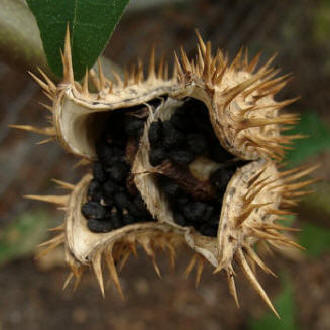
Once the seeds reach maturity, the body of the fruit opens up allowing them to be culvulses. Being that wind does not disseminate jimson weed's seed, they rely on other factors including animals, rain, and even humans to spread throughout their environment. If suitable conditions are found the seed will germinate.
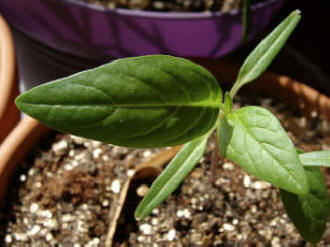 Germination of the seed result in the growth of a juvenile plant.
At this point, the conditions stated on the habitat page are
critical. Furthermore, once the plant reaches maturity it will be
more resistant to the pests listed on the interactions page.
Germination of the seed result in the growth of a juvenile plant.
At this point, the conditions stated on the habitat page are
critical. Furthermore, once the plant reaches maturity it will be
more resistant to the pests listed on the interactions page.
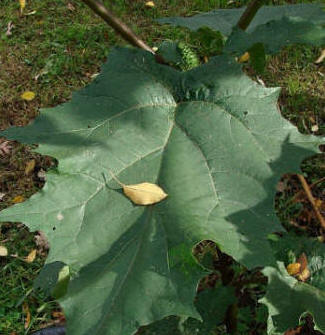 Jimson weed can reach relatively large sizes if the right conditions
are available. with the right soil, sunlight, and water jimson
weed can flourish up to five feet in height. At this point however
it's important to not confuse the plant with Brugmansia spp.
For a refresher on their differences continue to the
classification
page.
Jimson weed can reach relatively large sizes if the right conditions
are available. with the right soil, sunlight, and water jimson
weed can flourish up to five feet in height. At this point however
it's important to not confuse the plant with Brugmansia spp.
For a refresher on their differences continue to the
classification
page.
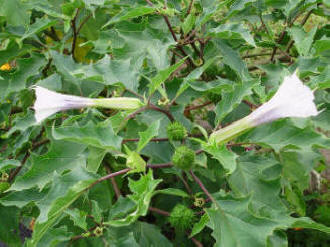 Mature Datura stramonium has the benefit of being able to
persist through adverse conditions. Also, at this point the plant
can readily reproduce and restart the life cycle. Being that jimson
weed is typically herbaceous it will also sometimes leave
nutrient pack bodies capable persisting through the winter or other
harsh conditions.
Mature Datura stramonium has the benefit of being able to
persist through adverse conditions. Also, at this point the plant
can readily reproduce and restart the life cycle. Being that jimson
weed is typically herbaceous it will also sometimes leave
nutrient pack bodies capable persisting through the winter or other
harsh conditions.
If you have followed the links through the pages, hopefully you have learned something about Datura stramonium, but if you have more question continue to the contact me page.
...Or return to the facts page/home page for even more Datura stramonium!
